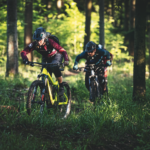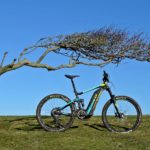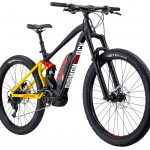Giant Full-E Plus 1 SX Pro 2018
kindly supplied for review by Rutland Cycling
Upon removing the bike from it’s box, I was reminded straight away of the ‘Marmite’ colour scheme that Giant seem to love inflicting upon their bikes. Great if you like 1970’s shell suits, but not so great if you don’t. I’m afraid that I fit into the latter category. Having said that, the bike models directly below and above this version, look very nice. I also sort of became used to the colour scheme as the weekend progressed, so in truth, it isn’t so bad.
The first thing of note for me, was the weight when lifting out of the box. I’ve become used to the weight of a hardtail, and had forgotten about the extra weight that full suspension adds. No spec weight is available, but from my possibly inaccurate digital scale, it weighed in at 23.54kg.
The second thing of note, was the conventional drive sprocket size, how I have missed that.
The build quality and finish of the bike is superb, and nothing immediately sprang to mind as a must change item. I looked at the saddle and thought “oh no this is going to fun” but it turned out to be superbly comfortable. I have, or rather had, the identical saddle fitted to my Giant XCT Advanced Plus 1 hardtail analogue mtb, and I had to remove and change it after just the first ride. A cycle saddle is a very personal item, and you certainly can’t judge a bike based upon that one item, especially as the one fitted to this model of Giant, is actually of very nice quality.
The bike came supplied with flat pedals, and I did consider swapping to my usual clipless set up, but the quality of the OE flat pedals appeared to be very good, so I thought that I’d just go with it. This was actually to be a smart move, as the conditions for one of the rides was very icy, and whilst I didn’t fall from the bike, I had several close calls, and being able to plant a foot down quickly saved the day. I’m still no fan of flat pedals, and did have a couple of pedal strikes, but I have been left pondering the pros and cons, so who knows.
The bike arrived in a fully charged condition, so after straightening the handlebars, setting the saddle height and suspension, checking tyre pressures, fitting the pedals and completing a general bike safety check, it was time for the first ride.
As with other bikes that I have previously reviewed/tried, the first ride is always a road ride over a set route and distance, and ridden in full power mode. I do this to gauge how the bike might generally be expected to perform over a given distance and elevation gain. Turning the bike on and thumbing up through the power settings was easy enough at a standstill, so I headed off. The bike set off at a brisk pace, but then so it should at a 360% assist level. Noise of the Yamaha drive unit was the first thing to strike me, and I spent the whole ride thinking that it was louder than the Bosch CX unit that I have become so familiar with. After switching back to back, I realised that this isn’t perhaps the case, and it is actually the tone of each that is different. To me, the Yamaha produces a deeper tone, whilst the Bosch a higher tone.
What I didn’t like was the surge effect from the transition from assist to no assist. This to me felt far more pronounced than on the Bosch system.
The next thing that I noticed was the wheel/tyre size. I have become used to 27.5 plus size, which certainly feels faster on the road, not that I ever try to venture onto roads.
Sadly, the frame size was slightly too small for me, and whilst I had zero discomfort from my upper body, my knees did complain from having to set the saddle height approximately 40mm lower than I would have liked. It is quite amazing how much difference that saddle height makes to bike comfort.
The ride also took in Kidds Hill, which is in the Strava top 100 climbs, and whilst it felt slow to me during the climb, it actually turned out to be my second fastest climbing time, oddly only bettered by the hub drive BH. That was a genuine surprise to me, and whilst we are only talking seconds between any of the bikes that have ridden up there, the Yamaha definitely felt the slowest. Something has to be right when you feel like that.
The above 19 mile ride consisted of 1,786ft elevation gain was completed with 42% of the battery capacity remaining. The conditions for the ride were very wet, and adversely windy.

Ride two was far more interesting and consisted of a 19 mile ride on the South Downs. Sadly, I have no ride stats, as the ride formed part of a longer ride utilising a second bike. Thankfully, the ground was pretty much frozen solid for the most part of the ride, so riding through thick muddy conditions, was pretty limited. Despite the discomfort of having the seat post set too low, I was really impressed by everything about the bike. The first observation was just how well suited to the bike, that the 2.6 tyre size is. This was my first experience of using a 2.6 tyre size and I really loved it. Grip from the OE Maxxis Rekon tyres was also surprisingly good, although I’m not sure that they would ever be my tyre of choice, as for some reason they really flung the muck up. I should add at this point, that chainstay clearance is quite tight and limited, which could present an issue when conditions turn bad.
If you include the off position, the bike has six modes. Off, Eco @100%, Tour @175%, Active @250%, Sport @300%, and Power @360%. For the road ride, I had thought what was the point of all of these settings, but riding off road, the settings made a lot of sense and I never once found the need to switch to the highest power mode. I did find myself flicking through modes quite frequently though, which is an observation that I also heard just this week on the EMBN Youtube channel. It wasn’t something that overly bothered me, but I did find the control button fiddly to use, and found myself consciously looking down at the button when switching between modes. Not something that would be ideal on tight or technical terrain, but that was just my observation, and I’m sure that others might not have an issue with it. Overall, I was more than happy with each of the power settings, tour particularly, was great to use. The display unit was also very clear and unobtrusive. Another surprise in respect of the display console, was seeing that it also had a cadence meter. I’m the last person to be interested in gimmicks and gadgets, but that is one aspect that I’d like to see fitted to all bikes.
In contrast to using the system on the road, when riding off road I don’t recall ever noticing the surge effect between the transition from assist to non-assist.
The motor did seem to over-run slightly on pedal strokes, but that is an aspect that I quite like. It can make a difference when crossing puddles, or sections of terrain where you might not otherwise be able to get a full pedal stroke in. It reminded me of rear hub drive.
Handling wise, I’m never going to claim to be a brilliant rider, but I did thoroughly enjoy the way that the bike inspired confidence with it’s very precise handling. The front end was effortlessly easy to lift whilst negotiating steps in climbs or for getting across rooted sections. The rear end felt heavy, but this I suspect was more down to the fact that I have spent so much time riding a hardtail eMTB, which is just so light by comparison. Down hill sections were a real blast of fun, and the relationship between the seating position and the handlebars worked so well for me. I enjoyed every second of the ride.
The cable operated dropper post also worked with ease, but I would have preferred the control lever to have been mounted on the left-hand side of the handlebar. Because of the power control button design, I’m not sure that it would ever be possible though as things just wouldn’t then fall easily to hand. Clearly there isn’t much that you can say about a bike after just a 19 mile ride, but it certainly didn’t disappoint. I’m sure that I shall think of more to say at a later stage.


Continued...
kindly supplied for review by Rutland Cycling
Upon removing the bike from it’s box, I was reminded straight away of the ‘Marmite’ colour scheme that Giant seem to love inflicting upon their bikes. Great if you like 1970’s shell suits, but not so great if you don’t. I’m afraid that I fit into the latter category. Having said that, the bike models directly below and above this version, look very nice. I also sort of became used to the colour scheme as the weekend progressed, so in truth, it isn’t so bad.
The first thing of note for me, was the weight when lifting out of the box. I’ve become used to the weight of a hardtail, and had forgotten about the extra weight that full suspension adds. No spec weight is available, but from my possibly inaccurate digital scale, it weighed in at 23.54kg.
The second thing of note, was the conventional drive sprocket size, how I have missed that.
The build quality and finish of the bike is superb, and nothing immediately sprang to mind as a must change item. I looked at the saddle and thought “oh no this is going to fun” but it turned out to be superbly comfortable. I have, or rather had, the identical saddle fitted to my Giant XCT Advanced Plus 1 hardtail analogue mtb, and I had to remove and change it after just the first ride. A cycle saddle is a very personal item, and you certainly can’t judge a bike based upon that one item, especially as the one fitted to this model of Giant, is actually of very nice quality.
The bike came supplied with flat pedals, and I did consider swapping to my usual clipless set up, but the quality of the OE flat pedals appeared to be very good, so I thought that I’d just go with it. This was actually to be a smart move, as the conditions for one of the rides was very icy, and whilst I didn’t fall from the bike, I had several close calls, and being able to plant a foot down quickly saved the day. I’m still no fan of flat pedals, and did have a couple of pedal strikes, but I have been left pondering the pros and cons, so who knows.
The bike arrived in a fully charged condition, so after straightening the handlebars, setting the saddle height and suspension, checking tyre pressures, fitting the pedals and completing a general bike safety check, it was time for the first ride.
As with other bikes that I have previously reviewed/tried, the first ride is always a road ride over a set route and distance, and ridden in full power mode. I do this to gauge how the bike might generally be expected to perform over a given distance and elevation gain. Turning the bike on and thumbing up through the power settings was easy enough at a standstill, so I headed off. The bike set off at a brisk pace, but then so it should at a 360% assist level. Noise of the Yamaha drive unit was the first thing to strike me, and I spent the whole ride thinking that it was louder than the Bosch CX unit that I have become so familiar with. After switching back to back, I realised that this isn’t perhaps the case, and it is actually the tone of each that is different. To me, the Yamaha produces a deeper tone, whilst the Bosch a higher tone.
What I didn’t like was the surge effect from the transition from assist to no assist. This to me felt far more pronounced than on the Bosch system.
The next thing that I noticed was the wheel/tyre size. I have become used to 27.5 plus size, which certainly feels faster on the road, not that I ever try to venture onto roads.
Sadly, the frame size was slightly too small for me, and whilst I had zero discomfort from my upper body, my knees did complain from having to set the saddle height approximately 40mm lower than I would have liked. It is quite amazing how much difference that saddle height makes to bike comfort.
The ride also took in Kidds Hill, which is in the Strava top 100 climbs, and whilst it felt slow to me during the climb, it actually turned out to be my second fastest climbing time, oddly only bettered by the hub drive BH. That was a genuine surprise to me, and whilst we are only talking seconds between any of the bikes that have ridden up there, the Yamaha definitely felt the slowest. Something has to be right when you feel like that.
The above 19 mile ride consisted of 1,786ft elevation gain was completed with 42% of the battery capacity remaining. The conditions for the ride were very wet, and adversely windy.

Ride two was far more interesting and consisted of a 19 mile ride on the South Downs. Sadly, I have no ride stats, as the ride formed part of a longer ride utilising a second bike. Thankfully, the ground was pretty much frozen solid for the most part of the ride, so riding through thick muddy conditions, was pretty limited. Despite the discomfort of having the seat post set too low, I was really impressed by everything about the bike. The first observation was just how well suited to the bike, that the 2.6 tyre size is. This was my first experience of using a 2.6 tyre size and I really loved it. Grip from the OE Maxxis Rekon tyres was also surprisingly good, although I’m not sure that they would ever be my tyre of choice, as for some reason they really flung the muck up. I should add at this point, that chainstay clearance is quite tight and limited, which could present an issue when conditions turn bad.
If you include the off position, the bike has six modes. Off, Eco @100%, Tour @175%, Active @250%, Sport @300%, and Power @360%. For the road ride, I had thought what was the point of all of these settings, but riding off road, the settings made a lot of sense and I never once found the need to switch to the highest power mode. I did find myself flicking through modes quite frequently though, which is an observation that I also heard just this week on the EMBN Youtube channel. It wasn’t something that overly bothered me, but I did find the control button fiddly to use, and found myself consciously looking down at the button when switching between modes. Not something that would be ideal on tight or technical terrain, but that was just my observation, and I’m sure that others might not have an issue with it. Overall, I was more than happy with each of the power settings, tour particularly, was great to use. The display unit was also very clear and unobtrusive. Another surprise in respect of the display console, was seeing that it also had a cadence meter. I’m the last person to be interested in gimmicks and gadgets, but that is one aspect that I’d like to see fitted to all bikes.
In contrast to using the system on the road, when riding off road I don’t recall ever noticing the surge effect between the transition from assist to non-assist.
The motor did seem to over-run slightly on pedal strokes, but that is an aspect that I quite like. It can make a difference when crossing puddles, or sections of terrain where you might not otherwise be able to get a full pedal stroke in. It reminded me of rear hub drive.
Handling wise, I’m never going to claim to be a brilliant rider, but I did thoroughly enjoy the way that the bike inspired confidence with it’s very precise handling. The front end was effortlessly easy to lift whilst negotiating steps in climbs or for getting across rooted sections. The rear end felt heavy, but this I suspect was more down to the fact that I have spent so much time riding a hardtail eMTB, which is just so light by comparison. Down hill sections were a real blast of fun, and the relationship between the seating position and the handlebars worked so well for me. I enjoyed every second of the ride.
The cable operated dropper post also worked with ease, but I would have preferred the control lever to have been mounted on the left-hand side of the handlebar. Because of the power control button design, I’m not sure that it would ever be possible though as things just wouldn’t then fall easily to hand. Clearly there isn’t much that you can say about a bike after just a 19 mile ride, but it certainly didn’t disappoint. I’m sure that I shall think of more to say at a later stage.


Continued...












